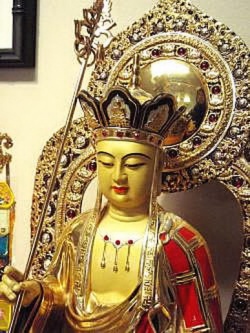Difference between revisions of "Buddha of self-enjoyment"
m (Text replace - "result" to "result") |
m (Text replace - "1" to "1") |
||
| Line 6: | Line 6: | ||
One of the four [[bodies]] of a [[Buddha]]. These four [[bodies]] correspond to the [[three bodies]]. They are | One of the four [[bodies]] of a [[Buddha]]. These four [[bodies]] correspond to the [[three bodies]]. They are | ||
| − | :( | + | :(1) the [[self-nature]] [[body]], which corresponds to [[the Dharma]] [[body]]; |
:(2) the [[body]] of self-enjoyment, which corresponds to the [[reward body]]; | :(2) the [[body]] of self-enjoyment, which corresponds to the [[reward body]]; | ||
:(3) the [[body]] of beneficence, which also corresponds to the [[reward body]]; | :(3) the [[body]] of beneficence, which also corresponds to the [[reward body]]; | ||
Revision as of 15:47, 8 September 2013
Buddha of self-enjoyment
[自受用身] ( Jpn jijuyushin )
One of the four bodies of a Buddha. These four bodies correspond to the three bodies. They are
(1) the self-nature body, which corresponds to the Dharma body;
(2) the body of self-enjoyment, which corresponds to the reward body;
(3) the body of beneficence, which also corresponds to the reward body;
(4) the transformation body, which is similar to the manifested body.
A Buddha of self-enjoyment is one who enjoys the benefits of enlightenment he attained as a result of his past meritorious achievements, such as Shakyamuni when he attained enlightenment under the bodhi tree. This concept of Buddha is contrasted with that of a Buddha of beneficence who responds to the people's desire and benefits them through the various teachings that they hope to hear. See also Buddha of limitless joy.
